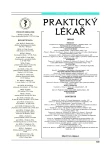Lethal course of tick-bor- ne encephalomyelitis in a fifteen-year old child
Authors:
V. Štruncová 1; D. Sedláček 1; K. Pizingerová 2; V. Amblerová 3; J. Kastner 4; Švecovám. 5
Authors‘ workplace:
Infekční klinika FN a LF UK, Plzeň
přednostka MUDr. J. Táborská, PhD.
1; Dětská klinika FN a LF UK, Plzeň
přednosta prof. MUDr. F. Stožický, DrSc.
2; Neurologická klinika FN a LF UK, Plzeň
přednosta prof. MUDr. Z. Ambler, DrSc.
3; Radiodiagnostická klinika FN a LF UK, Plzeň, přednosta
doc. MUDr. B. Kreuzberg, CSc.
4; Ústav mikrobiologie FN a LF UK, Plzeň, přednosta RNDr. K. Fajfrlík
5
Published in:
Prakt. Lék. 2005; 85(11): 635-637
Category:
Case Report
Overview
Described is a lethal course of tick-borne encephalomyelitis (TBE) in a fifteen-year old boy. The illness had a very short history, one-phase course, rapid development of disturbed consciousness, flaccid quadruplegia and brain-stem symptomatology. Examination of the cerebrospinal fluid (CSF) revealed a protein-cytological association, however, the magnetic resonance (MR) finding in the brain rather indicated a toxic myelinolytic affection of the stem. The diagnosis has been confirmed by the ELISA test demonstrating antibodies against the TBE virus in the serum and CSF. Besides differential diagnostics and treatment, discussed is the participation of other factors in the unfavorable course of the illness. Attention is brought to prevention through vaccination.
Key words:
tick-borne encephalitis - encephalomyelitis - CSF - magnetic resonance - differential diagnostics - therapy - prevention.
Labels
General practitioner for children and adolescents General practitioner for adultsArticle was published in
General Practitioner

2005 Issue 11
Most read in this issue
- Quality of life – defining the concept and its significance for medicine and health care
- Essential hypertension – a review
- Treatment and clinical manifesta- tions of primary intraocular lymphoma
- Risk factors and prevalence of bad posture in school-age children
